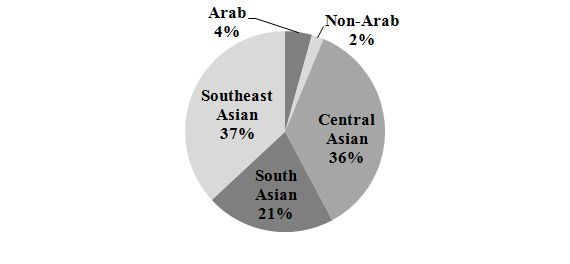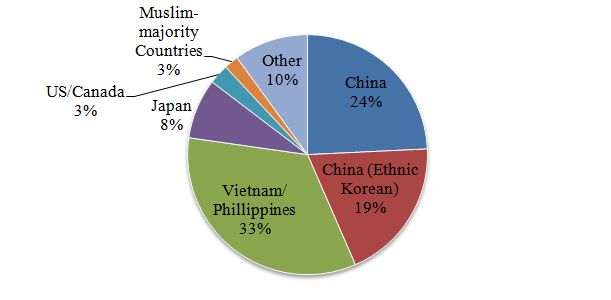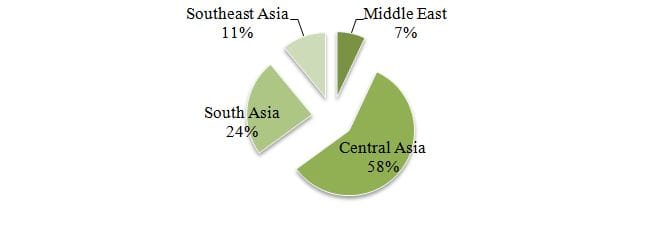This essay is part of a MAP series that aims to shed light on Korea-Middle East relations — their historical and cultural underpinnings, their energy-based and other economic aspects, and the geopolitical and other factors that have facilitated and constrained their development. See more ...
In 2001, there were only 34,000 Muslims living in Korea; today there are more than 150,000.[1] Furthermore, there are over 45,000 ethnic Korean Muslims.[2] In contrast to Europe, where over a thousand years of political, cultural, and religious interactions have shaped social attitudes toward Islam, Korea’s Muslim population remains relatively unnoticed, comprising only 0.3 percent of the total Korean population.[3] However, Islam in Korea is in the midst of great change. With the continuing increase in international migration over the past decade from Muslim-majority countries, the Korean Muslim community is transforming into a significant social and religious force.
This article seeks to examine how the Muslim community in Korea is growing, changing, and engaging with broader Korean society. It will provide a brief outline of Islam’s relationship with the Korean Peninsula before exploring the changes that are occurring in the Korean Muslim community’s demographic structure. It will focus on the roles that migration and da‘wa, or proselytizing, have played in Islam’s growth and what it means for the future of Islam in Korea.
Historical Context
Arab and Persian seafaring merchants first introduced Islam to the Korean Peninsula in the ninth century.[4] In the early eleventh century, Arab trade missions again arrived in Korea. Those that stayed built a mosque in the city of Kaesong, capital of the ruling Goryeo Dynasty in present-day North Korea. Following the Mongol conquest of Korea in 1270, a significant Muslim influx occurred as Korea was integrated into the multireligious Mongol empire. But for centuries, Islam’s presence and impact on Korean society was almost nonexistent. It was only at the beginning of the twentieth century that Islam experienced a second resurgence.
With Japan’s annexation of the Korean peninsula in 1910, over a million Koreans fled to neighboring China, where they encountered Chinese Muslim communities.[5] In the following decades, some of these Koreans converted to Islam and eventually returned after the country’s liberation in 1945.[6] The Korean War (1950-53) was the next period in which Islam began to have a noticeable impact on Korean society. Following North Korea’s invasion, the United Nations mobilized a multinational force to aid in the defense of South Korea. Turkey was one of the countries that responded to this request and sent more than 5,000 troops. This Turkish assistance continues to shape South Korean attitudes toward Turkey and Islam. In addition to fighting against the North Koreans, the Turkish soldiers also exposed many Koreans to Islam.
Supported by Imam Abdulgafur Karaismailoglu, who accompanied the Turkish forces, the first Korean Muslims—those who had resided in China during the Japanese colonial era—established the foundations of the Korean Muslim community.[7] For most of the next half century, Korean Muslims would remain largely confined to this small community of ethnic Koreans.
Migration and the Changing Face of Korean Muslims
Today, Muslims in Korea can be classified into two distinct groups: the traditional community and the immigrant community. The traditional community refers to those ethnic Korean converts to Islam who were born and raised in Korea. Most of them are well educated and have studied abroad in Muslim countries. They have been particularly active in propagating Islam in Korean society as well as in providing a social support network for newly arrived Muslims.
The second community is primarily comprised of foreign-born Muslim migrants. It is possible to further subdivide this community into five main groups based on region of origin: Arabs from the Middle East, non-Arabs from the Middle East including Turks and Iranians, Central Asians, South Asians, and Southeast Asians. The total number of Muslim immigrants, both legal and illegal, was 113,266 in 2012, the last year that the government reported these statistics (See Figure 1).[8]
Figure 1. Foreign-born Muslim Residents in Korea by Region (2012)
Source: Korean Immigration Service Statistics 2012 (Ministry of Justice, 2012)
Among these groups, Arab and non-Arab Muslim migrants from the Middle East account for only six percent of the overall number of foreign-born Muslims (See Figure 2).[9] Non-Arab Muslims have the lowest growth rate among Muslim residents in Korea, primarily coming from Turkey and Iran.[10]
Figure 2. Foreign-born Muslim Residents in Korea by Region by Percentage (2012)
Source: Compiled by Kwon Jeeyun. Data from Korean Immigration Service Statistics 2012 (Ministry of Justice, 2012)
Arab Muslims in Korea have a variety of goals that frequently stem from their country of origin. For instance, many international students from the Gulf have settled relatively easily in Korea with the support of savings from their home countries. Muslims from the Maghreb also tend to be international students or independent businessmen.[11] However, Arab Muslims from Egypt, Sudan, and elsewhere are often manual laborers.
As with most cases of migration, Muslim migration to Korea has often relied on social networks to preserve and enhance migrants’ religious lives. These activities are highly effective for adjusting to a new culture. For instance, while Muslim migrants account for two-thirds of all Muslims in Korea, they account for over 90 percent of attendees at religious services.[12]
Pathways of Muslim Migration to Korea
The growing number of Muslims in Korea emerges from two particular phenomena. The first is international marriages between Korean nationals and foreign-born Muslims. According to the Korean Immigration Service, there were more than 140,000 migrants from international marriages in 2012.[13] Of these, 4,687 were Muslims, constituting approximately three percent of the total (See Figure 3).[14]
Figure 3. International Marriage Migrants by Country of Origin (2012)
Source: Compiled by Kwon Jeeyun. Data from Korean Immigration Service Statistics 2012 (Ministry of Justice, 2012)
Of these Muslim migrants, there were only 302 migrants from the Middle East, including 245 men and 57 women (See Figure 4).[15]
Figure 4. Muslim International Marriage Migrants by Region (2012)
Source: Korean Immigration Service Statistics 2012 (Ministry of Justice, 2012)
The ratio of Muslim immigrants from the Middle East was only seven percent of all Muslim immigrants by international marriage, with Central Asia accounting for nearly 60 percent (See Figure 5).[16]
Figure 5. Muslim International Marriage Migrants by Region (2012)
Source: Compiled by Kwon Jeeyun. Data from Korean Immigration Service Statistics 2012 (Ministry of Justice, 2012)
The growing number of Muslim immigrants by intermarriage is related to acquiring Korean nationality, as foreigners can acquire nationality by staying married to a Korean for more than two years.[17] Most foreign spouses of a Korean national receive either the F-2-1, F-5-1, or F-6 visa. Among these, the F-2-1 and F-6 visas only allow for a short-term stay and employment, while the F-5-1 visa denotes a permanent resident.[18] In the coming years, the number of F-5-1 visas can be expected to grow, given that the employment and immigration situation in Korea will continue to be attractive to foreigners.
The second phenomenon relates to Muslim students studying in Korea.[19] Since 2008, the Korean government has actively sought to attract foreign students, and it is providing scholarships to over 3,000 students.[20]
According to the Korean Ministry of Justice, the total number of students from predominantly Muslim countries was 4,937 (3,330 male, 1,607 female) in 2012. Of these Muslim students, 979 were from the Middle East, including 254 women. By country of origin, the number of students from Saudi Arabia was highest (301, including 36 women), and the second largest group was from Iran (179, including 58 women). Even so, only 4.2 percent of Muslim students in 2012 came from Islamic countries.[21]
Yet this number has grown each year, and local universities are helping by actively seeking to attract more Muslim students. For example, many Korean universities, such as the Korea Advanced Institute of Science and Technology and Hanyang University, have begun to establish halal restaurants and musallas (prayer rooms) for Muslim students. There is even a student council for Saudi students at Kookmin University.[22]
After finishing their degrees, many of these Muslim students become professionals and enjoy positive relationships with their fellow Korean workers. Under these conditions, their activities in Korean society enable Koreans to become acquainted with Islam and Muslim cultural values.
The Korean Muslim Community and Da‘wa Activities
The boundary between the traditional community and the immigrant community is blurring because of the increasing number of intermarriages between Muslim immigrants and Koreans. Yet da‘wa in Korea still has two major variants that depend on two Korean Muslim communities. The da‘wa activities of the traditional Muslim community have focused on education, publishing, and establishing Islamic facilities. In contrast, the da‘wa activities of the Muslim immigrant community have focused on networking and facilitating the migration of Muslims, frequently through intermarriage.
1. Creating Social Networks in the Immigrant Community
With the growth in the Muslim immigrant community in Korea, social mobilization and networking have slowly started to take shape. These networks have formed around local mosques, they have aimed to provide a social safety net for new immigrants, and they have enabled the promotion of da‘wa. As Muslims have formed their own social networks, they have maintained their unique religious and cultural identity internally while expanding their community and creating an Islamic environment in Korean society. This has made it possible for Koreans to come to accept foreign-born Muslims as their friends, coworkers, and neighbors. Islam has become familiar to Koreans, and some of them have become involved in learning about and converting to Islam.
2. Intermarriage of Muslim Immigrants
The other method of expanding the presence of Muslim immigrants in Korea is through the marriage of Koreans and Muslims. Given that Muslims from many developing countries are keen to live in Korea for economic reasons, marriage to a Korean remains one of the easiest ways to migrate to Korea. With rapid economic development in the 1980s and the opening up of the Korean labor market in the 1990s, Muslim migration, from laborers to highly educated workers, has consistently grown (See Figure 6).[23]
Figure 6. Growth in Foreign-born Muslim Residents in Korea (1994-2012)
Source: Compiled by Kwon Jeeyun. Data from Korean Immigration Service Statistics 2012 (Ministry of Justice, 2012)
Intermarriage is a strong tie between two cultures and societies. Multicultural families are a more comfortable way for many Koreans to accept Islam as a religion, and by connecting the foreign nature of Islam with Korean spouses, Muslim families can have an enormous impact on integrating Muslim values into mainstream Korean society. Furthermore, these families have played a key role in introducing other Koreans to Islam through da‘wa activities.
Conclusion
As the Islamic scholar Ismail al-Faruqi once noted, “All Muslims who have left their homelands to settle in the non-Islamic countries, regardless of the external factors that led to their migration, are to see themselves as missionaries rather than immigrants in the usual sense of the term.”[24] With more than 150,000 Muslims now living in Korea, the Korean Muslim community has shown surprising growth potential. Driving this growth have been different modes of migration driven by a variety of purposes, including marriage, education, and employment. But the consolidation and deepening of the Korean Muslim community will be driven by the da‘wa activities of both the traditional and immigrant communities. From helping newly-arrived migrants settle in Korean society to enhancing mainstream Korean awareness and interaction with Muslims, da‘wa activities will be crucial to the continued rise of Korean Islam.
[1] Song-gyu Kim, “Islam in Korea” Dong-A Ilbo, 22 July 2001; Song Kyunghwa and Ahn Soochan, “I Am a Korean-Muslim,” The Hankyoreh, 16 May 2011.
[2] Jeeyun Kwon, “The Understanding of Women in Korean Islam,” Muslim Christian Encounter 5, 1 (2012): 51.
[3] Frank. J Buijs and Jan Rath, “Muslims in Europe: The State of Research,” IMISCOE Working Paper, University of Amsterdam, 2002, 4-5, http://dare.uva.nl/document/144737.
[4] Hee-soo Lee, The History of Korean-Islamic Cultural Exchange (Seoul: Mundoksa, 1991), 59-66.
[5] Alexander R. Mackenzie, Church and Missions in Manchuria: A Survey of a Strategic Field (London: World Dominion Press, 1928), 52.
[6] J. Miller Graham, East of the Barrier (New York: Evangelical Literature, 1920).
[7] Jeeyun Kwon, “Islam in Korea,” Muslim Christian Encounter 2, 1 (2009): 54-57.
[8] Korean Immigration Service Statistics, Ministry of Justice, 2012.
[9] Korean Immigration Service Statistics, Ministry of Justice, 2012. Compiled by Kwon Jeeyun.
[10] Jeeyun, “Islam in Korea.”
[11] Heesun Cho, “Muslim Communities in Korean Society,” Korean Journal of Middle East Studies 27, 2 (2008): 89.
[12] Daesung Kim, “A Study on the Research Model for the Muslim Immigrant in Korean Society,” Korean Association of Islamic Studies 18, 1 (2008): 181.
[13] Korean Immigration Service Statistics, Ministry of Justice, 2012.
[14] Korean Immigration Service Statistics, Ministry of Justice, 2012. Compiled by Kwon Jeeyun.
[15] Korean Immigration Service Statistics, Ministry of Justice, 2012.
[16] Korean Immigration Service Statistics, Ministry of Justice, 2012. Compiled by Kwon Jeeyun.
[17] Heesun Cho, “Muslim Immigrants in Korea: Their Intermarriage with Koreans and the Settlement,” Mediterranean Review 11, 3 (2009): 88.
[18] “Basics of Immigration,” Hi Korea: E-Government for Foreigners, http://www.hikorea.go.kr/pt/index.html.
[19] Jeeyun, “The Understanding of Women in Korean Islam.”
[20] Chungsoon Lee, “Study Regarding the Factor of Korean Conversion to Islam after the 1970’s,” The Korean Evangelical Theological Society Biblical & Theology Journal 16 (2011): 83.
[21] Korean Immigration Service Statistics, Ministry of Justice, 2012.
[22] Sangmin Ko, “Halal Restaurant for Muslim students,” Yonhap News Online, 7 March 2013, http://news.naver.com/main/read.nhn?mode=LSD&mid=sec&sid1=102&oid=001&aid=0006133244.
[23] Korean Immigration Service Statistics, Ministry of Justice, 2012. Compiled by Kwon Jeeyun.
[24] Ismail Al-Faruqi, “On the Nature of Islamic Da‘wah,” International Review of Mission 65, 260 (October 1976): 391-409.
The Middle East Institute (MEI) is an independent, non-partisan, non-for-profit, educational organization. It does not engage in advocacy and its scholars’ opinions are their own. MEI welcomes financial donations, but retains sole editorial control over its work and its publications reflect only the authors’ views. For a listing of MEI donors, please click here.













